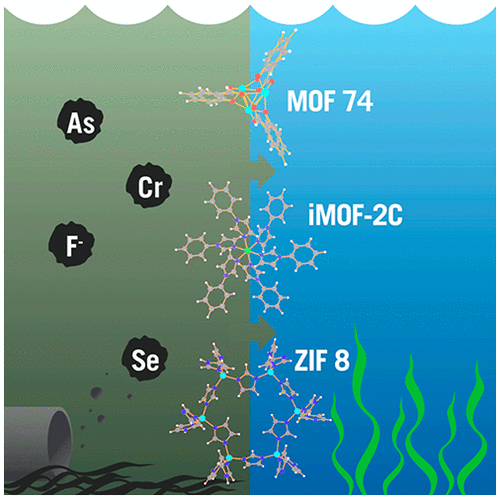当前位置:
X-MOL 学术
›
J. Phys. Chem. Lett.
›
论文详情
Our official English website, www.x-mol.net, welcomes your
feedback! (Note: you will need to create a separate account there.)
Capture of Toxic Oxoanions from Water Using Metal–Organic Frameworks
The Journal of Physical Chemistry Letters ( IF 4.8 ) Pub Date : 2021-09-16 , DOI: 10.1021/acs.jpclett.1c02550 Robert Stanton 1 , Emma Russell 1, 2 , Hayden Brandt 1, 2 , Dhara J Trivedi 1
The Journal of Physical Chemistry Letters ( IF 4.8 ) Pub Date : 2021-09-16 , DOI: 10.1021/acs.jpclett.1c02550 Robert Stanton 1 , Emma Russell 1, 2 , Hayden Brandt 1, 2 , Dhara J Trivedi 1
Affiliation

|
The effective capture of common water contaminants using metal–organic frameworks (MOFs) presents a remedy for current environmental concerns arising from the pollution of water sources. The crystalline porous nature of MOFs, their high internal surface area, and exceptional tunability make them suitable candidates for sequestration and removal of pollutants. However, the efficiency of capture depends largely on the nature of the interactions between the anions and the MOF. In this work, to elucidate the host–guest interactions involved in the capture of such pollutants, we explore three characteristically different MOFs: ZIF-8, iMOF-2c, and MOF-74. We demonstrate by ab initio electronic structure calculations the importance of exploiting qualitatively different binding modes for strong host–guest interactions available in the selected MOFs. Our simulations reveal the relative performance of neutral and cationic adsorbents while underscoring the importance of employing MOFs containing open metal sites for the efficient uptake of anions.
中文翻译:

使用金属-有机框架从水中捕获有毒氧阴离子
使用金属有机框架 (MOF) 有效捕获常见的水污染物为当前因水源污染引起的环境问题提供了一种补救措施。MOF 的结晶多孔性质、高内表面积和出色的可调性使其成为隔离和去除污染物的合适候选者。然而,捕获效率在很大程度上取决于阴离子和 MOF 之间相互作用的性质。在这项工作中,为了阐明捕获这些污染物所涉及的主客体相互作用,我们探索了三种不同的 MOF:ZIF-8、iMOF-2c 和 MOF-74。我们通过ab initio证明电子结构计算了在所选 MOF 中利用不同的结合模式进行强主客体相互作用的重要性。我们的模拟揭示了中性和阳离子吸附剂的相对性能,同时强调了使用含有开放金属位点的 MOF 来有效吸收阴离子的重要性。
更新日期:2021-09-23
中文翻译:

使用金属-有机框架从水中捕获有毒氧阴离子
使用金属有机框架 (MOF) 有效捕获常见的水污染物为当前因水源污染引起的环境问题提供了一种补救措施。MOF 的结晶多孔性质、高内表面积和出色的可调性使其成为隔离和去除污染物的合适候选者。然而,捕获效率在很大程度上取决于阴离子和 MOF 之间相互作用的性质。在这项工作中,为了阐明捕获这些污染物所涉及的主客体相互作用,我们探索了三种不同的 MOF:ZIF-8、iMOF-2c 和 MOF-74。我们通过ab initio证明电子结构计算了在所选 MOF 中利用不同的结合模式进行强主客体相互作用的重要性。我们的模拟揭示了中性和阳离子吸附剂的相对性能,同时强调了使用含有开放金属位点的 MOF 来有效吸收阴离子的重要性。































 京公网安备 11010802027423号
京公网安备 11010802027423号